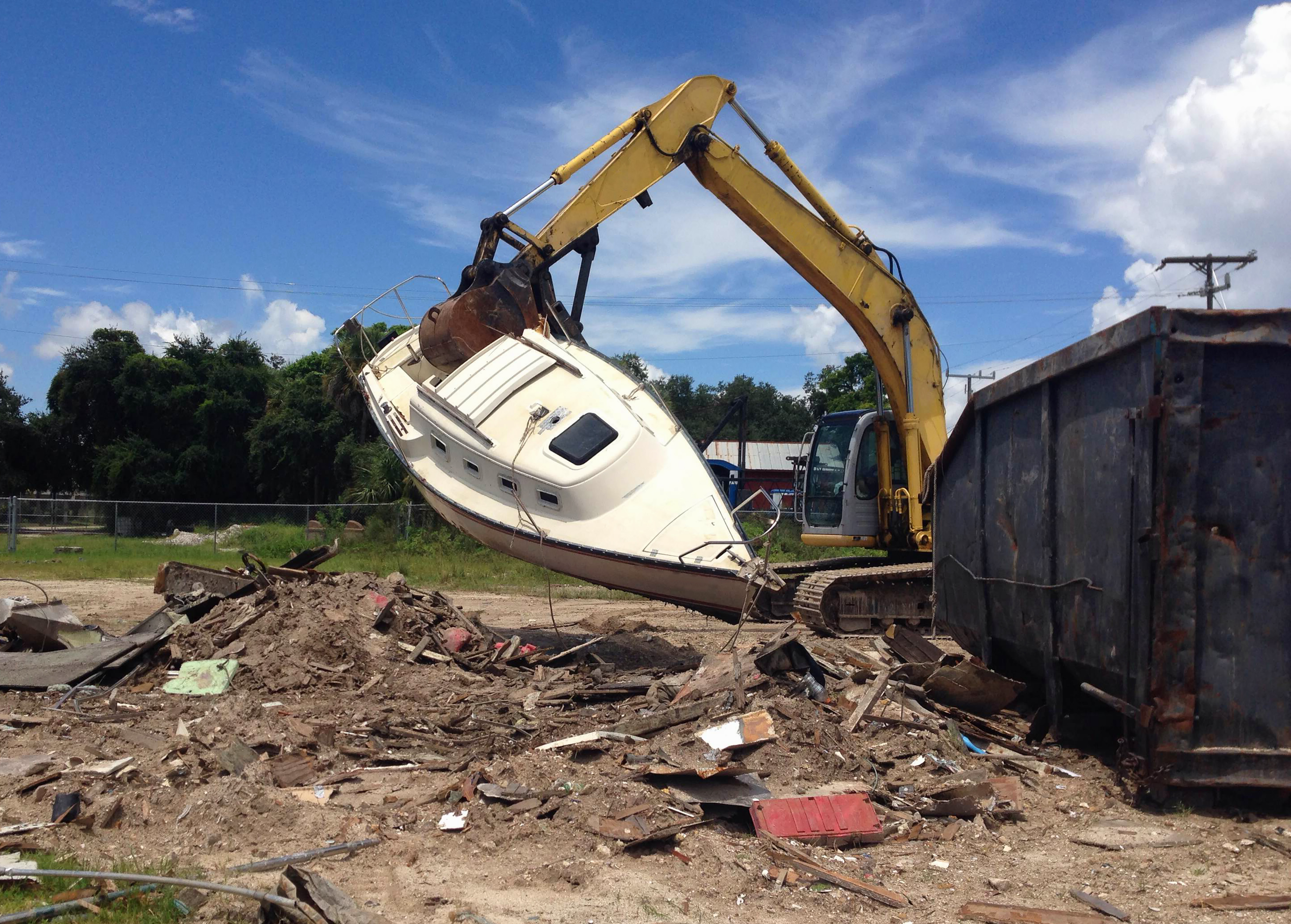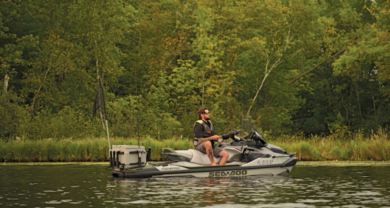Aging, recycling hulls a looming crisis

Millions of boats built during the glory days of the 1970s and 80s are now coming to the end of their life. We can’t just shove them all into landfill. So what happens with all these old hulls?
If there’s one thing we’re good at, it’s building boats. According to the National Marine Manufacturer’s Association, there are more than 12 million recreational boats in the United States right now. And that figure continues to grow, with an estimated 238,000 new powerboats sold in 2015 alone.
What we’re not good at is figuring out what happens to all of these boats when they reach the end of their life. It’s a question that’s coming to the fore as millions of boats mass-produced during the boom years of the 1970s and 1980s are now reaching the end of their days. The discussion around end-of-life boats has come to prominence in the last few years, and has been the subject of multiple industry conferences and think-tanks which have sought to raise awareness of the problem within the boating industry, and come up with workable solutions.
The consensus among delegates attending a Sustainability In The Marine Industry conference held last November in conjunction with METS is that worldwide, somewhere between 35 to 40 million boats are now approaching the end of their life. The challenge is that no one wants to touch them because there is no money to be made in scrapping old boats. Right now, the vast majority of old boats are simply cut up and buried in landfill. But with literally tens of millions of boats headed for the dump over the next several years, and each hull having the potential to leech a variety of toxic chemicals like formaldehyde into the ground water, end-of-life boats represent a growing problem.
Funding boat disposal
“The US and Canada represent probably half the world boating market,” said NMMA President Thom Dammrich. “But this is not an issue that has reached a widespread level of consciousness in North America. In that sense, we’re far behind Europe in thinking about what to do with end-of-life boats. Philosophically, no one would argue that it would be desirable to find a way to recycle boats at the end of their life. The question is, who is going to pay for it?”
The question of who should pay to dispose of old boats isn’t easily answered, but it’s a question the U.S. industry would be wise to tackle before the EPA and other regulatory agencies elect to answer it for them. In France, a new federal Eco Tax specifically created to fund the disposal of end-of-life boats comes into effect on January 1, 2018.
“The tax will be applied to all recreational water craft, from sailboats to power boats to canoes – all boats up to 24 meters (78 feet) in length,” explains Pierre Barbleu, manager of France’s APER Network. “The details are still being debated but it will most likely be applied at the point of registration, since in France all boats must be registered. There is a high cost to dismantling boats, and no one wants to pay. So, the government has decided who will.”
The problem with this approach, said Barbleu, is that the number of old boats in the pipeline grossly outweighs the number of new boats being sold.
“There are boats now coming to the end of their life from over the past 40 years,” he said. “But today fewer people buy boats so the cost, proportionally, is going to be higher than it should. Now the tax will make getting a boat even more expensive, and discourage new people from becoming interested in boating. It’s going to hurt everyone.”
Here in North America, abandoned and derelict boats are a growing problem in a number of areas – and one that can be expected to only get worse as more and more boats reach the end of their days. The sight of these rotting vessels not only casts boating in an unfavorable light – particularly to the eco-conscious millennials that represent the incoming cohort of buyers – it represents a significant drain of tax dollars with the cost of recovery and disposal averaging $450 per foot.
Boats as material banks
For generations boats have been produced following a linear, “cradle-to-grave” economic model of build, use, and dispose. While this may have been fine in the days when wood was the primary boat building material, the adoption of fiberglass changed everything. The two main issues are the environmental considerations of dumping huge quantities of fiberglass into landfill, and the lost value of potentially reusable materials.
In his keynote presentation at the 2016 METS Breakfast Briefing, Steven Beckers, president of the Brussels-based Lateral Thinking Factory, spoke about the benefits of designing boats with a view to being broken up and recycled at the end of their life. “
Materials should be used, not consumed,” said Beckers. “We need to think of products like boats as raw material banks for the future. Materials appreciate in value over time. Designing boats with an eye to their eventual deconstruction will allow boats to retain greater value at every stage of their life, including the end of it.”
Beckers advocates a circular economic model, which follows a “cradle-to-cradle” concept of build, use, then recycle into something else. He contends that the cost of recycling boats can be dramatically reduced if they were designed from the outset to be easier to deconstruct. Because recyclable materials retain some residual value through the boat’s life, he says a boat’s initial acquisition cost can be partially offset by the future value of its recyclable content. Beckers likens it to commercial ships, which retain considerable value as scrap metal even after they’re no longer fit to go to sea.
“Recreational boat builders need to adopt this way of thinking,” he said. “Because with the present way of doing things there is too much waste, and it costs everybody too much money.”
In the auto industry, the concept of retained value at end-of-life has been embraced for years, allowing dealers to profitably accept end-of-life vehicles on trade knowing they can be subsequently resold at wholesale for scrap. Not only do the metal components retain value as scrap material, but so do the plastic and fiberglass parts (General Motors helped develop fiberglass recycling technologies back in the 1970s, when the material was first introduced in the Corvette). Today, fiberglass auto parts are profitably shredded into fiberglass slivers with multiple uses, including serving as a non-corrosive substitute for traditional iron rebar in certain types of concrete.
Fiberglass can also be recycled to make other fiberglass products – including boats. Ryds Battindustri AB, Sweden’s largest boat builder, began experimenting with fiberglass recycling about 10 years ago. While its efforts were put on hold by the 2008 economic downturn, the company has since produced prototype boats built with up to 20% recycled fiberglass content, and hopes to bring the technology to its production models.
With millions of old boats headed for landfill over the next decade the boating industry faces what can only be described as a looming environmental problem, and one with the potential to become a public relations quagmire. Taking a leadership role now in making the industry more environmentally sustainable can only benefit manufacturers and dealers alike, while simultaneously providing a long-term solution to the growing problem of end-of-life boats.






Nice article, about a subject that has to be kept at the forefront in the minds of our industry leaders and innovators. The only way that millions of tons of indestructible composite boat hulls are going to handled in volume, and with due consideration for the environment, is for a commercially viable recycling, or preferably ‘upcycling’ method to be developed, which will ultimately make lots of money for somebody.
Meanwhile, lets hope that we can learn for the past, and strive to avoid compounding the problem in the coming decades by totally rethinking how we construct and use the leisure yachts of the future.
Many thanks to Craig Ritchie for attending the ‘Sustainability in the Marine Industry’ Conference (SIMI16) held alongside METSTRADE last November, and for your excellent coverage.
Please look out for details about SIMI17, to be held at the same venue this coming November, where we will be continuing along the exploratory path, and striving to make the Leisure Marine Industry more sustainable in years to come.
Peter Franklin. YachtMedia, The Netherlands. (Joint organiser of SIMI16 with Quaynote Communications.)
Do you know of other companies building with recycled fibreglass?